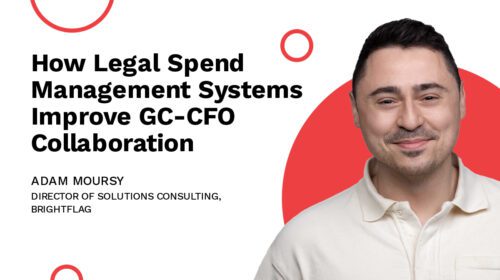Data Analytics for In-House Legal Teams: The Getting Started Guide
“Is your department data-driven?”
It’s clear to anyone who values their corporate career that there’s only one acceptable answer to that question. What’s less clear is how to actually make the answer true.
In-house attorneys know the feeling better than most. They sit alongside business departments that seem to speak exclusively in metrics—yet their own professional training included minimal mentions of data.
But, as the rise of legal operations continues to illustrate, lawyers are more than capable of learning and applying the finer arts of business management. Given the right guide*, even a potentially intimidating discipline like legal data analytics can quickly become an approachable process.
(*This is that guide.)
Part I: The What & Why of Legal Data Analytics
Before diving into the details, let’s first confirm the essential traits and broader benefits that make legal data analytics a topic worth exploring.
Legal data analytics defined
Data analytics is the process of collecting and interpreting numerical evidence for the purposes of drawing objective conclusions and informing future decisions. In the context of a corporate legal department, this typically means analyzing work executed and resources invested in the hopes of developing more efficient operating strategies.
It’s also important to note that legal data analytics is a practice, not a product. Specialized technology may aid and accelerate your efforts, but it should not be seen as a prerequisite. You can start with the tools you have today.
The unique advantages of analytics
Data analytics is not a natural proficiency among corporate legal departments. For most, it’s a skill that must be consciously developed over time. But for those in-house teams that choose to make the investment, the results can be transformative.
Objective feedback
Higher quality feedback yields faster performance improvements.
It’s a correlation you’ve likely seen illustrated in countless persona scenarios (ex. tracking screen time) and professional situations (ex. surveying employee satisfaction). Yet its impact on corporate legal operations is still consistently overlooked.
Compared to other business departments, the feedback available to in-house legal teams has historically been less prevalent and more subjective. As a result, it’s been more difficult to agree on how work is progressing, where changes should be made, and what those changes ought to be.
Legal data analytics help resolve this tension by increasing the volume and validity of feedback.
With more evidence – of greater objectivity – to reference, you can fundamentally change performance improvement from a vague goal into a systematic process.
Strategic clarity
The downstream impact of stronger feedback loops is dramatic.
Instead of struggling to maintain situational awareness, you can easily gauge progress. Instead of diluting focus across dozens of initiatives, you can quickly spot the few risks and opportunities that demand urgent action. And instead of anxiously wondering whether you made the right move, you can calmly monitor the analytics to learn the truth.
The combined effect is a confidence that permeates team culture and, more often than not, yields impressive business results.
Business credibility
Business colleagues will have more respect for the hard numbers you present than the legal nuances contained in their calculation.
This is partly a product of subject matter expertise, of course. But it also stems from the fact that your peers likely expect corporate attorneys to avoid concise, data-backed declarations in favor of long explanations full of caveats.
Rather than resenting this stereotype, consider the credibility you could gain by defying it.
Whether your goal is to demonstrate value, defend a decision, or secure additional resources, legal data analytics can supply the figures you’ll need to tell a persuasive story.
Part II: Core Activities in Legal Data Analytics
Teams, technologies, and objectives will vary, but the analytics process remains the same. And although you will likely execute some phases more proficiently than others, all five need a place in your plans.
Setting filters
Gathering the most data is not the goal. Gathering the data most likely to inform your strategic priorities is.
That’s why we always encourage our customers to start from a specific question. That way they can immediately filter their entire universe of data down to a more manageable sample.
Maybe there’s a topic you’re already curious about. Or maybe the questions you need answered are already streaming in from the C-suite. However you organize and prioritize these inquiries, though, be clear about which role you’re asking analytics to play.
- Descriptive. Confirms the facts of what happened or is happening.
- Diagnostic. Explains why it happened or is happening.
- Predictive. Models what may happen and what its impact could be.
- Prescriptive. Suggests the strategy most likely to deliver desired results.
The function you seek defines the parameters of the filter you set.
Sourcing data
Now that you’ve narrowed your analytical ambitions, it’s time to locate the data capable of answering your inquiries.
The richest and most relevant data sources for most corporate legal departments are their matter management, legal spend management, and contract management platforms. If you haven’t yet implemented specialized software, though, you can still manually (if tediously) compile data by reviewing root documents like invoices and contracts.
This in-house intelligence can also be supplemented by third-party sources, such as reports from government agencies or industry research groups. But sooner or later, you will likely need to create the supply to satisfy your demands.
One popular example is law firm scorecards. In an effort to rigorously measure the qualitative dimensions of their outside counsel relationships, more in-house legal teams are creating home-cooked solutions to fill the feedback gap.
As long as your criteria are objective and consistent, such frameworks are perfectly valid sources for data analysis.
Running reports
Now that you’ve set the perimeter of your search, it’s time to extract datasets, perform calculations, and capture conclusions.
This is the phase where computational power is at a premium. An AI engine, for example, can generate reports exponentially faster than even the most statistically savvy legal ops pro manipulating a spreadsheet.
But remember, “crawling” or “walking” with more manual methods is almost certainly more valuable than delaying all analytics initiatives until you have top-of-the-line technology. (Your inability to execute endless reports could even be a positive constraint that clarifies your priorities!)
Communicating insights
Data does not speak for itself. If you expect it to be heard effectively and interpreted accurately, then you’ll need to frame it within a story.
The first step in your communication plan should be specifying the intended audience. Not all insights will be equally relevant, interesting, or valuable to all stakeholders. Also, some reports may contain sensitive or privileged data that require strict access controls.
Next, consider the unique priorities and responsibilities of your audience. What are the insights they’ll be most curious about? What do they absolutely need to know in order to play their part in the broader business strategy?
Finally, you need to select the format for your story and the frequency with which you’ll share it.
Sometimes a lighter touch will suffice, like a data dashboard that your audience can reference at their leisure. Sometimes the company calendar will define the presentation schedule and topics for you. Or, in the case of especially timely or potentially surprising insights, perhaps only an impromptu in-person meeting will do.
Adapting strategies
The ultimate value of legal data analytics will be determined by their application. Because without action, insights are merely trivia.
Consensus and cooperation will define success at this final stage. But if the science executed throughout the first three phases is valid, and the story crafted in the fourth phase is clear, then you’ll be in a strong position to forge alignment around a specific strategy.
Plus, assuming analytics is a practice you’re committed to for the long term, the action you choose to pursue can trigger the start of a valuable new feedback loop.

Part III: Legal Data Analytics by Business Objective
Just as filters help you focus each analytical inquiry, categories are a useful way to organize your collective efforts. And considering the end goal of analytics is strategic impact, categorizing by business objective may be the logical place to start.
Legal data analytics for team productivity
You can think of analytics from this category in terms of volume and output. Their shared goal is a greater understanding of the scale and type of work your department is pursuing.
Sample metrics
- Legal service requests received
- Matters opened
- Matters closed
- Contracts completed
- Invoices processed
- Patents granted
Potential applications
- Descriptive. Confirm whether contract completion increased last quarter.
- Diagnostic. Determine which departments are driving up legal service requests.
- Predictive. Forecast the number of matters that will be open at end-of-year.
- Prescriptive. Decide whether to shift the focus of IP development efforts.
Legal data analytics for financial accountability
To accurately assess the value of your legal department productivity, business executives need to understand the costs of that production. Analytics from this category provide a detailed perspective.
Sample metrics
- Internal vs. external legal spend
- Spend by matter type
- Spend by vendor
- Forecasted spend
- Budget compliance rate
- Savings achieved
Potential applications
- Descriptive. Confirm whether actual spend exceeded budgeted spend.
- Diagnostic. Identify which matters contributed to the budget overrun.
- Predictive. Forecast next quarter’s spend with Law Firm A.
- Prescriptive. Highlight top target areas for negotiating discounts.
Legal data analytics for operational efficiency
Time and money are two constraints every business department shares. The distinguishing trait among excellent strategic operators is a record of stretching more results from the same (or fewer) resources. Analytics from this category help monitor your progress in forging that reputation over time.
Sample metrics
- Legal spend as a percentage of revenue
- Blended hourly rate (outside counsel)
- Legal spend per lawyer (in-house)
- Contract cycle time
- Matter resolution rate
- Matter cycle time
Potential applications
- Descriptive. Compare the blended hourly rates of Law Firm A and Law Firm B.
- Diagnostic. Identify which types of contracts take the longest to review.
- Predictive. Forecast the likely close date for an active matter.
- Prescriptive. Determine whether outsourcing IP work would be more cost-efficient.
Start with what you know
By now you can hopefully see that there’s no reason to delay your practice of legal data analytics.
You already know where a lack of objective feedback is limiting team performance. You already know which storytelling techniques will resonate with executive leadership. And you’ve since learned where to find the raw materials that produce impactful reports.
So don’t be discouraged by the fact that your early efforts probably won’t reflect the peak of analytical sophistication. You’ll close that gap faster than you think if you can just take one step forward today.
To learn more about how Brightflag’s intuitive, AI-powered platform can help your in-house team harness the power of their data, book a demo with us today.



